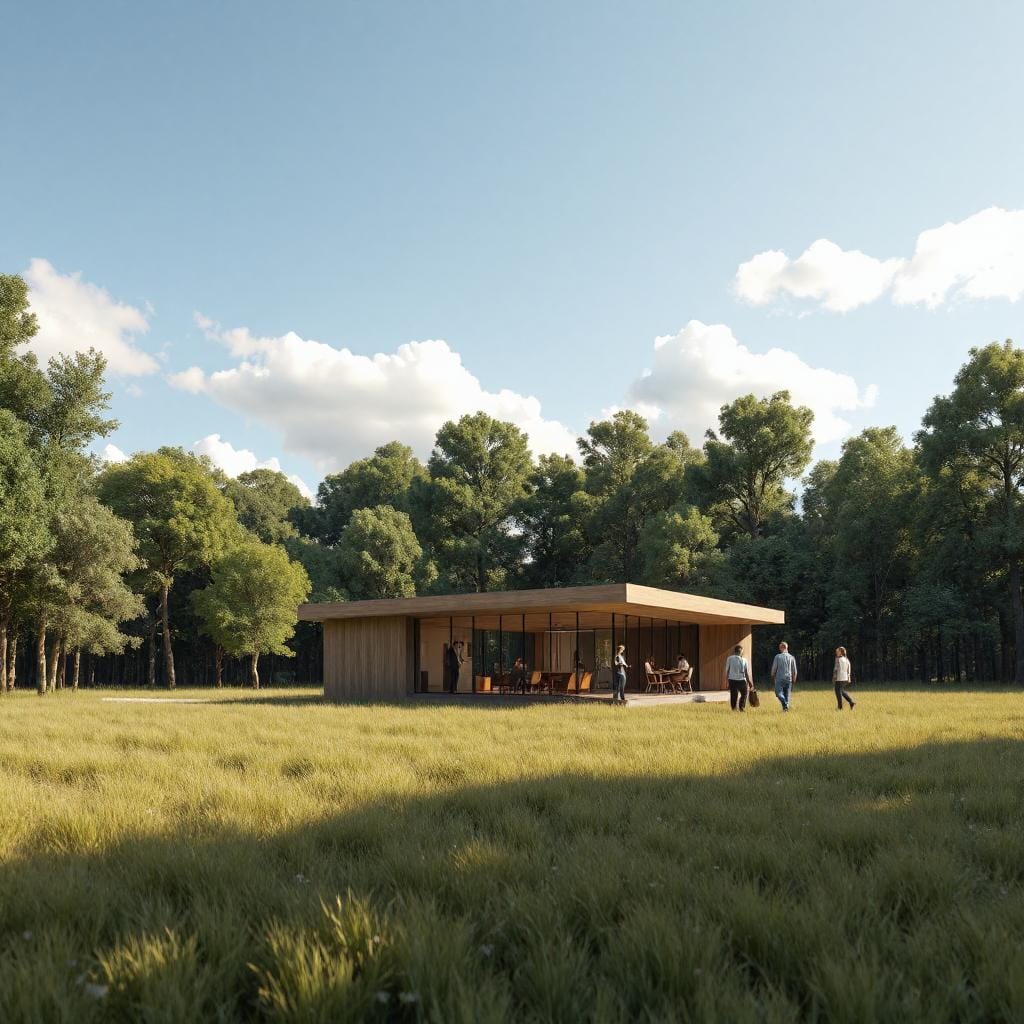Ecotonal Design Series:
A Biophilic Revolution
By Charles Fadem | Senior Designer
Amid the return-to-office movement, organizations have aimed to unite their teams around a common goal: maintaining the emotional and physical health many have found through hybrid work, while preserving productivity, community, and in-person collaboration. This is no small task. Today's wellness standards challenge traditional workplace design, which often prioritizes technology and desk space at the expense of health and happiness.
However, it’s possible to achieve both efficiency and wellness with a brand-new strategy: Ecotonal Thinking. This approach relinquishes our preconceived notions about the pros and cons of the traditional workplace. It starts anew with the natural world as a point of departure, creating workspaces to balance the modern knowledge workers’ need for health and connection to nature—without sacrificing productivity. As companies continue to navigate the return-to-office shift, this is how modern organizations can achieve the unity everyone seeks.
Hybrid work has also highlighted the value of newfound technological flexibility. The limitations of power cords, wired internet, and fixed screens are fading away, radically changing how and where work occurs. Remote work has also offered healthier routines—time with family, home-cooked meals, better rest, and refreshing midday walks. These changes have improved happiness and boosted productivity. This flexibility has also activated spaces beyond the modern commercial office, transforming them into fruitful workplaces. Balancing access to the natural world with technology is a delicate challenge. While office buildings leverage technology effectively, they often limit the full benefits that traditional biophilic design strategies can provide.
Ecotonal Thinking shifts the way we perceive workspaces. It's not about abandoning the commercial office for remote work but recognizing new opportunities to design environments that originate from the natural world, free from reliance on built infrastructure. Ultimately, the future of workspaces is less about location and more about how these spaces foster human connection, nurture well-being, and empower people to thrive.
How do we begin designing a commercial workspace rooted in the natural world, unburdened by and independent of existing infrastructure? This question became the foundation of the research IA conducted. Aiming to understand where work happens, why people work in certain environments based on health and psychology, and how technology influences each workspace. In tandem, IA explored the the key benefits and challenges of working immersed in nature.
Early in the process, the team had to identify the boundary between knowledge work conducted within built infrastructure and work conducted outside of it, as well as what defines the absence of infrastructure. What IA found wasn’t a clear boundary but a gradient—a spectrum of work zones ranging from modern commercial offices to mountaintops and everything in between. IA distilled these varied work zones into a comprehensive chart, mapping the evolution and diversification of work environments.
Traditional Office vs. Remote Work Environments
The Office Spectrum
At one end of the spectrum is the traditional office, fully equipped with necessary infrastructure. At the other end is the "Open Sky" environment, with minimal infrastructure. Between these extremes are two key zones that have become more prominent.
Remote Office Zone
The Remote Office Zone includes home offices, coworking spaces, drop-in offices, hospitality venues, coffee shops, and transportation hubs. These spaces, once considered peripheral to traditional work environments, have become accelerated.
Ecotonal Office Zone
Closer to the “Open Sky” end of the spectrum, the Ecotonal Office Zone encompasses urban green spaces, semi-rugged areas, backyards, rural areas and ranches, and even national parks. The flexibility has allowed employees to explore and experiment with these environments while maintaining productivity.
Key Factors Affecting Wellness and Productivity
The comfort and productivity of knowledge workers in these zones are influenced by several key factors:
- Control of Space: Can employees tailor their environment to meet their sensory needs regarding light, temperature, sound, and smell? These elements significantly impact both wellness and productivity.
- Wi-Fi & Power Connectivity: Does the worker have reliable and easily accessible connectivity to leverage technology effectively?
- Restrooms & Amenities: Are there sufficient comforts and privacy for personal needs, hygiene, food, and drink?
- Specialty Clothing: Is there a need for specific attire due to environmental or social norms?

Understanding Ecotonal Opportunity Zones
The shift toward diverse Work Opportunity Zones (WOZs) presents a unique chance to balance wellness and efficiency. Transitioning between different zones can reduce stress levels through direct biophilic exposure.
Each WOZ offers distinct advantages and disadvantages. Experiences within these zones vary based on location and the type of knowledge work performed. Activating the full potential of these zones requires personal resources, such as financial means and freedom of movement, along with organizational support, including flexibility and technological infrastructure.
If work can happen anywhere, then all workspaces—regardless of their location—deserve equal consideration in design. This includes environments beyond traditional urban settings, which can be challenging for some. The preference for working from home is well-documented and not something to be feared. Instead, it is an opportunity to pay close attention to what employees want and need to feel healthy and productive. Home offices offer maximum control over the environment, reliable connectivity, private restrooms, and the comfort of casual attire.
Ecotonal Office Zones offer knowledge workers the opportunity to immerse themselves directly in nature. However, these environments present challenges, including limited control over workspace conditions, varying access to restrooms and food, and the need for specialized clothing. Additionally, technology can be unpredictable in outdoor settings—a key insight from IA’s research.
Professionals who work outdoors, such as emergency responders, scientific researchers, solar panel technicians, and military personnel, are acquainted with these zones. They have mastered the use of technology in the wild, offering valuable lessons that modern knowledge workers can leverage to enhance productivity.
Biophilia Backwards
The Ecotonal Office concept has emerged as a promising work option, allowing knowledge workers to engage with the natural environment as they carry out their tasks. This raises a critical question: How were designers addressing health in the workplace before this profound shift?
Traditionally, biophilic design in workplaces included elements like potted plants, artificial fountains, synthetic circadian lighting, live-edge wood, and increased natural light through glazing. Indirect biophilia—like biophilic geometry and murals—enhanced traditional workplaces but also introduced challenges, including complex irrigation systems and expensive mechanical and maintenance-heavy setups. Despite these enhancements, many employees in biophilic-rich environments still preferred a hybrid work model, suggesting that traditional biophilic design focused more on harm reduction than fostering genuine well-being.
Now, consider the possibility of spending an entire workday—enjoying morning coffee, attending meetings, and collaborating with colleagues—fully immersed in nature. Ecotonal offices not only makes this possible but also enhances both wellness and productivity simultaneously.
The future of commercial office design transcends the binary choice between traditional offices and remote work. It reimagines how workspaces can embrace the natural world through thoughtful design and minimal technological interventions. Rather than retrofitting traditional spaces to mimic nature, starting with nature itself allows for the creation of environments that are both comfortable and efficient, aligning with how people work best.
Part Two explores the journey of designing a workspace that bridges technology and nature. Field studies and data collection revealed the challenges and opportunities of a fully connected workday outdoors, leading to the creation of the Ecostation—a workstation designed to help knowledge workers thrive in Ecotonal environments, balancing productivity with the restorative qualities of the outdoors.
In 2024, IA Interior Architects, supported by the 2023 ONEder grant from OneWorkplace, launched a research project that led to the creation of "The Ecostation," authored by Lisa K Bambach, (SEGD, University of Washington) and Charles Fadem (IA). This critical intervention in Ecotonal Work zones is designed to enable knowledge work while maximizing wellness without compromising productivity. In parts two and three we will focus on experimentation with knowledge work performed exposed to the elements, and end with the design of an architectural intervention that achieves commercial office design by way of Ecotonal Thinking.

